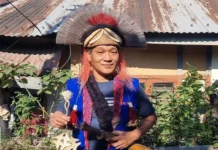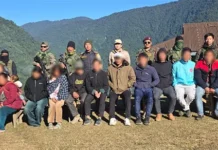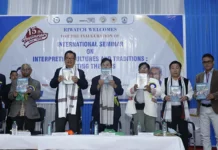[Badak Yomgam]
Wellness tourism is a form of travel focussed on promoting health and wellbeing through physical psychological and spiritual activities. Unlike medical tourism, which is reactive, wellness tourism is proactive, aimed at maintaining or improving one’s health. It involves a wide range of activities, including spa treatments, yoga retreats, meditation and healthy eating, all in a setting that encourages relaxation and personal growth.
This type of tourism is deeply interconnected with rural tourism, with rural areas providing the ideal setting and in turn benefiting economically. This relationship is particularly evident when cultures serve as a perfect foundation for a holistic travel experience, moving beyond conventional sightseeing to offer profound personal rejuvenation.
Across the state, natural resources serve as focal points for both types of tourism. The Dirang hot springs in West Kameng district is a well-known wellness destination due to its therapeutic, mineral-rich waters. However, its value is amplified by its rural setting, which allows tourists to combine a healing retreat with an immersive cultural experience in nearby villages. Similarly, the remote Thingbu hot springs in Tawang district is not only a natural wellness site but also an integral part of the rural landscape, offering adventurous travellers a chance to interact with local communities while seeking mental and physical rejuvenation.
Anini valley (Dri hot springs) further exemplifies this with its pristine environment and hot springs, where the remote, rustic setting makes the experience an authentic rural one, far removed from commercialised spas, thereby directly linking a natural wellness element with a rural setting.
The integration of wellness and rural tourism in Arunachal Pradesh is also driven by its unique cultural heritage. The state’s focus on promoting homestays offer organic, farm-to-table food and a ‘digital detox’ experience, perfectly aligning with the goals of wellness tourism while directly supporting local economies. A digital detox involves deliberately disconnecting from electronic devices to focus on real-life interactions and the remote, quiet setting of these rural locations. It makes it easier for travellers to fully unplug and immerse themselves in the experience. The promotion of Ayurveda and traditional healing practices also leverages the local tribal knowledge and medicinal plants of the rural communities, providing an authentic and culturally rich wellness experience.
In conclusion, the Arunachal government is a key enabler of this interconnected model. The state government, through its tourism policy, is actively promoting the development of eco-friendly resorts, homestays and hot springs. By supporting initiatives that empower local communities and preserve cultural and natural assets, the government ensures that tourism is both an economic driver and a sustainable practice. This approach ensures that tourism benefits local communities while providing a genuinely enriching experience for travellers, proving that the state’s tourism model is both authentic and sustainable, benefiting both the visitors and the local population. (The contributor is a PhD scholar at NEHU, Shillong)




